Opinion
It’s ‘the beautiful game’, so why shouldn’t its players glam up?
Anne Hyland
Senior CorrespondentThe Matildas’ success so far at the World Cup, and the joy millions of Australians have experienced in watching their achievements, is a reminder of how far women’s sport has come.
The games are being watched in record numbers, and among the fans in the crowds are young boys and men cheering on athletes who are being the best versions of themselves and showcasing their phenomenal skills. If girls need further affirmation that playing soccer is not “boyish” – or simply encouragement to be physically active as many studies show too many teenage girls ditch sport altogether – then the World Cup has given it to them.
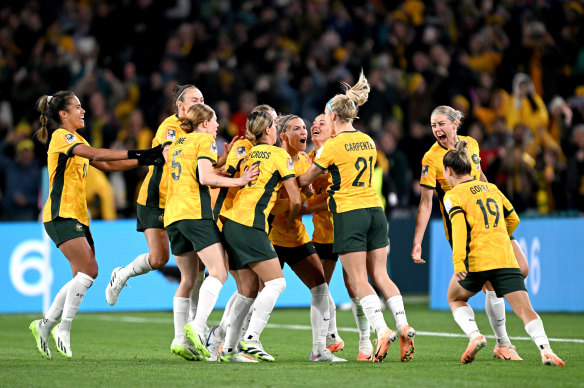
Australia celebrate at full-time in their first World Cup game.Credit: Getty
And yet, there are views on how female athletes, and in this case soccer stars, should look even as they take centre stage. Female sports stars should be athletic but not too masculine. They should be feminine but then are criticised for wearing make-up or having unusual or elaborate hairstyles during a game.
Conversations on couches, in parks, pubs and stadiums — anywhere people are watching the games — have focused not only on the players’ and coaches’ skills and strategy, and the mistakes that have meant some teams exit the tournament, but there have also been discussions about the players’ appearance.
Whether they’re the Matildas, England’s Lionesses or Nigeria’s Super Falcons, the conversations go something like this: “Is she wearing false eyelashes or is that mascara?” “Does she have lipstick on?” “Is that blush or are her cheeks just flushed?” “How can she run with that much hair?”
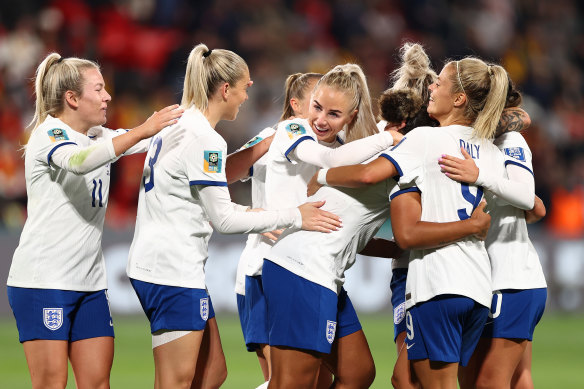
Lauren James of England celebrates with teammates during their win over China.Credit: Getty
Fans, new ones and the diehards, are divided on whether make-up does have a place in soccer or in sport. Why would you wear make-up while you’re playing 90 minutes of intense, exhausting soccer, never mind the extra injury time? And yet, make-up has been worn by tennis players at grand slam events and by athletes at the Olympics, in events outside those such as gymnastics that require it. And who hasn’t been to their local gym and seen women working out wearing make-up?
Other armchair critics go as far as to suggest female soccer players who care about their appearance are somehow more show ponies and lesser athletes. It’s a silly argument. It’s also easy to forget David Beckham’s multitude of hairstyles that set fashion trends during his time as a world-class player.
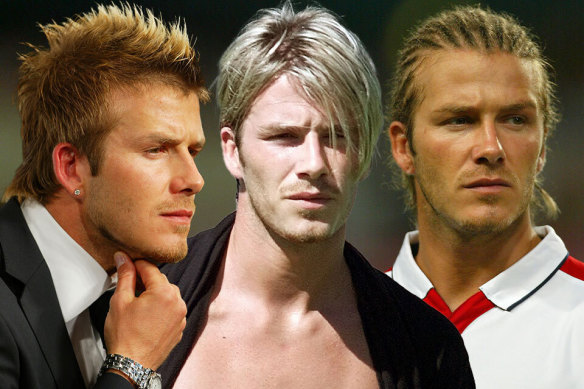
Former England captain and star soccer player David Beckham and his many hairstyles that set fashion trends. Credit: NIne
There is an early conditioning for all of us to judge a woman by how she looks.
In late 2022, Arsenal Women’s Football Club became a partner with beauty company Il Makiage as it launched a campaign celebrating women athletes. Matildas’ player Steph Catley, who is a full-time defender for Arsenal, said in an interview earlier this year that the deal reflected the changing nature of sponsorship for women’s sport, and then offered several other insights into why female sports stars are damned if they do or don’t wear make-up.
“I suppose a lot of people look at female athletes and might use some unkind words or think that we don’t like to be girly, or we don’t like to do our make-up or care about our skin,” Catley told Women’s Health magazine. “I think the alignment of this partnership does smash that stereotype. We are different people away from the field, and we do enjoy certain things other than playing football.”
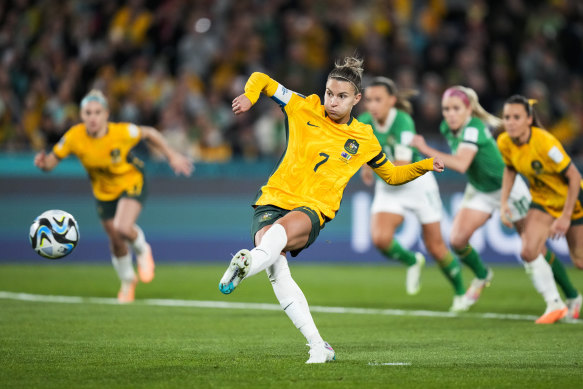
Steph Catley’s penalty proved the difference between the Matildas and Ireland in their World Cup opener.Credit: AP
“We want young girls looking at us and wanting to play football, so if that sort of target audience starts on TikTok or starts with the make-up industry then they find their way to football, I think that’s a win for us.”
However, appealing to young girls via social media with a beauty company can be fraught. While the admirable aim might be to draw them into sport, or make them admire sportswomen, any parent of daughters would tell you now of a growing trend of girls as young as 10 wearing make-up, from mascara to lip gloss, often to school. And primary and secondary schools are struggling with how to address it, ranging from a laissez-faire attitude to the other extreme of detentions for students wearing false eyelashes.
Girls using social media are bombarded with how-to make-up videos, beauty products that they are told they need, or fashion trends, from clothes to hairstyles, on sites from YouTube to TikTok to Instagram.
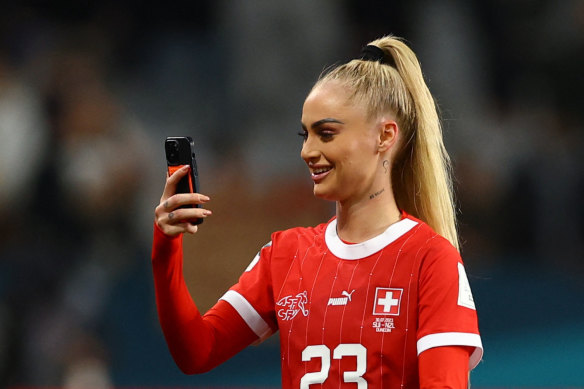
Switzerland’s Alisha Lehmann celebrates after the match against New Zealand. Credit: Reuters
Hairdressing salons, like the one I visit, which is suburban and mid-range, tell me how in the past six months, they have been shocked at the growth in girls as young as nine coming in. They are accompanied by parents, and the kids are asking for highlights or for their hair to be coloured a bright blue or purple. Any of those hair treatments would set back parents at least $150.
Television, cinema, magazines and now social media have long told girls and women what kind of beauty the world values. For sportswomen, it remains a difficult area to navigate, especially when they become world-class athletes. For young girls, it’s been ever thus. But it has been shown that playing sport can help with the body-image insecurities that social media in particular has increasingly imposed upon them, which is another reason we should be cheering the Matildas.
Game on.
Anne Hyland is an award-winning writer and a senior correspondent for The Sydney Morning Herald and The Age.